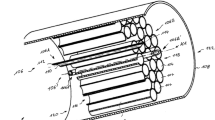Summary
BACKGROUND: Functional efficacy of synergistic terminal end-to-side nerve graft repair in a median nerve defect model in nonhuman primates was recently published elsewhere. The purpose of this study was to investigate the morphology of the end-to-side repair site and the nerve graft used after synergistic terminal end-to-side nerve graft repair. METHODS: Experiments were carried out in seven adult baboons. Synergistic end-to-side nerve graft repair bridging from the terminal motor branch of deep branch of the ulnar nerve to the thenar motor branch of the median nerve was performed after transection of the median nerve at forearm level. Specimens were harvested three months after surgery. Chromotrope aniline blue was used for staining neural collagenic connective tissue. S100-antibody was used to quantify the number of Schwann cells. Axon counts were performed using NF (neurofilament) antibody staining. To enable profound morphological assessment, specimens were harvested 5 mm proximal to the end-to-side nerve graft repair site (deep branch of ulnar nerve), at the end-to-side nerve graft repair site (proximal graft), and at the distal end-to-end nerve graft suture site. The contralateral terminal deep branch of ulnar nerve served as a control. RESULTS: The area of collagenic connective tissue was 6% larger at the end-to-side repair site and 28% larger at the distal end of the nerve graft. Highest mean values were found at the distal site of the nerve graft. This was due to very strong collagenization of the nerve graft of animal number six. In other words, there was a moderate enhancement of collagenic connective tissue within the nerve graft in six animals. Schwann cell counts showed similar values within all nerve segments. There was no difference when compared to nonoperated control. The number of axons distal to the end-to-side repair site was smaller by 19% on average. Additionally, we found an average 23% decrease of axons at the end-to-end coaptation site compared to data of the deep branch of ulnar nerve. CONCLUSIONS: The results in this morphological study of synergistic end-to-side nerve graft repair at the level of very peripheral terminal motor branches in a nonhuman primate model demonstrate effective distal axonal sprouting and successful Schwann cell survival. As expected, we found a modest increase of neural collagenic connective tissue within the nerve graft in most animals (6 out of 7 animals).
Zusammenfassung
GRUNDLAGEN: Funktionelle Effektivität von synergistischer terminaler End-zu-Seit-Nervenrekonstruktion via Nerventransplantat an einem Nervus-medianus-Defektmodell an Pavianen wurde bereits gezeigt. Das Ziel dieser Studie war die Morphologie des Spendernervs und des Transplantates nach synergistischer terminaler End-zu-Seit-Nervenrekonstruktion zu untersuchen. METHODIK: Die Untersuchungen wurden an 7 erwachsenen Pavianen durchgeführt. Synergistische terminale End-zu-Seit-Nervenrekonstruktion via Nerventransplantat erfolgte vom terminalen motorischen Ast des Ramus profundus des Nervus ulnaris zum motorischen Thenarast des Nervus medianus nach Durchtrennung des N. medianus auf Höhe des mittleren Drittels des Unterarmes. Präparate wurden 3 Monate nach der Primäroperation gewonnen. Färbemethoden: Chromotrop Anilin Blau für neurales Bindegewebe; S100-Antikörper für Schwann'sche Zellen; NF-(Neurofilament-)Antikörper für Axone. Um entsprechende Aussagen tätigen zu können, wurden histologische Schnitte auf mehreren Höhen durch Spendernerv und Nerventransplantat angefertigt. Der nicht operierte R. prof. nervi ulnaris der Gegenseite wurde zur Kontrolle herangezogen. ERGEBNISSE: Die Fläche an neuralem Bindegewebe verglichen mit dem Spendernerv war direkt am End-zu-Seit-Rekonstruktionsbereich um 6 % größer und am distalen Ende des Nerventransplantates 28 % größer. Der höchste Mittelwert fand sich im distalen Bereich des Transplantates, wobei dieser Wert durch eine sehr starke Kollagenisierung eines Tieres hervorgerufen wurde. Man fand also eine moderate Vermehrung des neuralen kollagenen Bindegewebes. Die Zahl an Schwann'schen Zellen zeigte in allen Bereichen ähnliche Werte. Es ergaben sich keine statistisch signifikanten Unterschiede zur Kontrollgruppe. Die Zahl der Axone distal der End-zu-Seit-Koaptation war im Mittel um 19 % geringer. Zusätzlich stellten wir eine Verminderung der Axonzahl im distalen Bereich des Nerventransplantates um 23 % fest. SCHLUSSFOLGERUNGEN: Die Ergebnisse dieser morphologischen Studie an einem Pavian-Modell zeigen die Effektivität eines axonalen Aussprossens nach synergistischer terminaler End-zu-Seit-Koaptation via Nerventransplantat und ein erfolgreiches Überleben von Schwann'schen Zellen im Transplantat, sowie eine moderate Vermehrung an neuralem kollagenem Bindegewebe im Nerventransplantat.
Similar content being viewed by others
Author information
Authors and Affiliations
Corresponding author
Rights and permissions
About this article
Cite this article
Schmidhammer, R., Hausner, T., Zandieh, S. et al. Morphology after synergistic terminal end-to-side nerve graft repair: Investigation in a nonhuman primate model. Eur Surg 37, 220–227 (2005). https://doi.org/10.1007/s10353-005-0166-z
Received:
Accepted:
Issue Date:
DOI: https://doi.org/10.1007/s10353-005-0166-z




